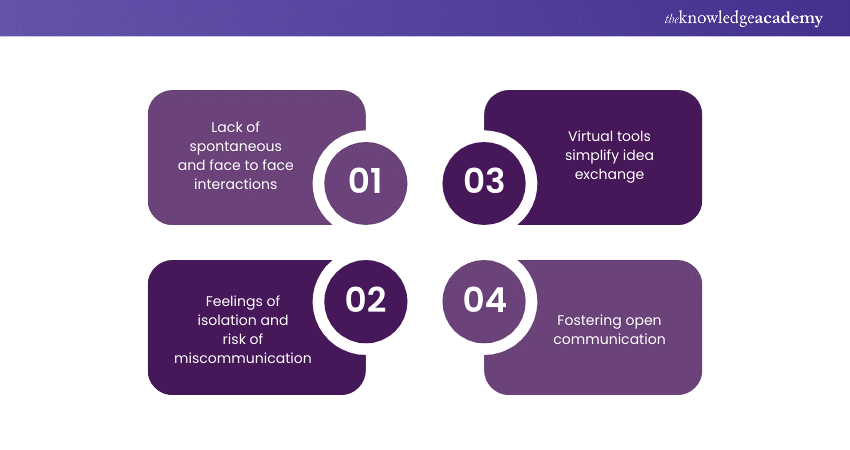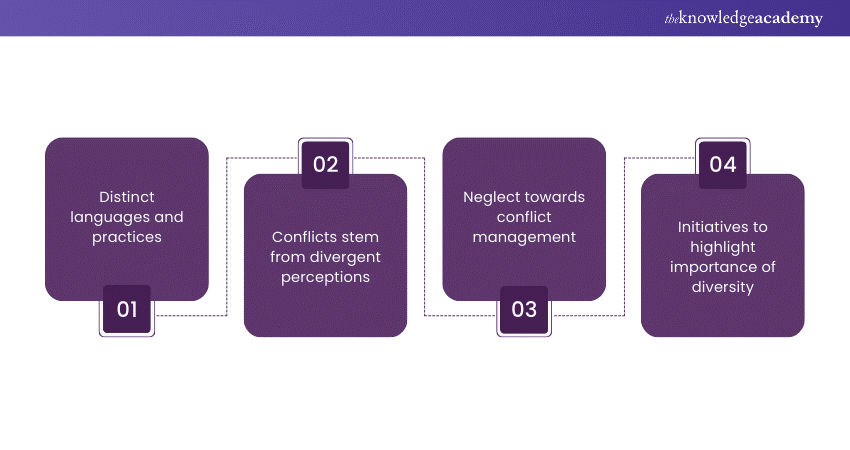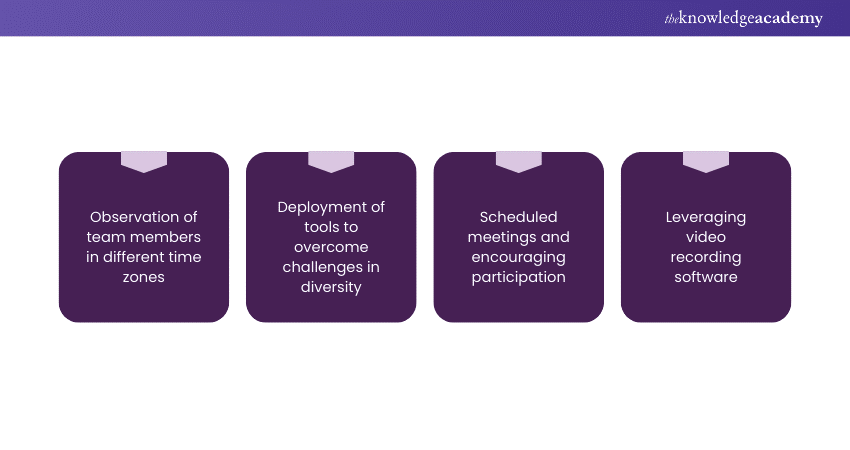We may not have the course you’re looking for. If you enquire or give us a call on +55 8000201623 and speak to our training experts, we may still be able to help with your training requirements.
We ensure quality, budget-alignment, and timely delivery by our expert instructors.

As many companies and workplaces have shifted to remote work, the many Challenges of Virtual Teams have become increasingly prevalent. As organisations embrace virtual collaboration, they encounter hurdles ranging from communication barriers to cultural diversity issues. This dynamic shift towards remote teamwork underscores the importance of understanding and addressing these challenges effectively. Explore this blog on the Challenges of Virtual Teams to learn about the complexities of managing Virtual Teams and the solutions for these challenges.
Table of Contents
1) What are Virtual Teams?
2) Virtual Team challenges & their solutions
a) Overcoming communication hurdles
b) Filling the void of social interaction
c) Building trust in remote collaboration
d) Managing cultural variances
e) Cultivating team unity from a distance
f) Mitigating distractions in virtual workspaces
g) Balancing time zone disparities
h) Streamlining prompt responses
i) Establishing effective workflow structures
j) Elevating productivity in virtual team environments
3) Conclusion
What are Virtual Teams?
Virtual Teams represent a gathering of individuals collaborating from separate locations, exemplifying one of the core hurdles faced by such teams, i.e. physical distance. These teams encompass employees situated in different offices or individuals conducting work remotely from their homes.
Additionally, the advent of advanced communication technologies, such as email and various collaborative tools, has fuelled the proliferation of Virtual Teams, a trend that has only accelerated following the COVID-19 pandemic in 2020.
Moreover, this phenomenon highlights the ongoing evolution of challenges inherent in Virtual Team dynamics, necessitating innovative strategies for effective remote collaboration. A Virtual Team essential refers to a collective of workers who collaborate and communicate utilising digital platforms.
While they may share a common physical location, Virtual Teams are typically dispersed, operating remotely from various locations within a city, state, or even across different countries, sometimes spanning continents!
Now such teams may also be referred to as "geographically dispersed teams" or "remote teams," all signifying individuals working collaboratively despite physical separation. They achieve this through the utilisation of online tools, such as project management software, to facilitate communication and collaboration.
Given the geographical distances inherent in Virtual Teams, establishing trust among team members and fostering effective communication are crucial to prevent costly misunderstandings.
It is important to note that overcoming this challenge can be particularly daunting, as interpersonal bonds often thrive through in-person interaction. However, employing virtual project management methodologies can provide valuable assistance in this regard.
Virtual Team challenges & their solutions
Virtual teams face challenges such as communication barriers, time zone differences, and building trust. Solutions include establishing clear communication channels, utilising time zone converters, fostering transparency and accountability, and conducting regular team-building activities.
Embracing technology, setting clear goals, and promoting work-life balance are key strategies for success. Here are the various challenges encountered with their corresponding solutions:
a) Overcoming communication hurdles

Communication challenges rank as the primary concern for most businesses when managing virtual teams. Unlike traditional offices, there's a lack of spontaneous, face-to-face interactions and non-verbal cues.
It is crucial to note that prolonged periods without contact can lead to feelings of isolation and increase the risk of miscommunication within virtual teams. To address these challenges, leverage various communication channels such as virtual classrooms, video conferencing, collaboration platforms, digital whiteboards, and screen sharing.
Moreover, these tools promote transparency and simplify the exchange of complex ideas. Prioritise deploying these technologies before commencing work with a virtual team. Additionally, hiring individuals with strong communication skills can facilitate smoother collaboration.
Furthermore, foster a culture of open communication within your teams, encouraging accessibility and regular dialogue. Providing training on effective communication can also mitigate project obstacles and conflicts within virtual teams.
b) Filling the void of social interaction
Virtual teams face the challenge of limited social interaction, as team members naturally enjoy informal discussions about work, personal interests, and hobbies. These interactions provide relief from stress and foster camaraderie, which usually lacks in virtual workspaces.
Here are the actions to take:
a) Encourage informal communication through instant messaging during downtime.
b) Incorporate social time into the work calendar for non-work-related interactions.
c) Organise team competitions with rewards to foster engagement.
d) Introduce brain games, quizzes, or puzzles to enhance team bonding.
Virtual teams encounter the absence of genuine social engagement, missing the spontaneous discussions that occur during breaks in traditional office settings. To mitigate this, encourage team members to use instant messaging for casual catchups during free time.
You can also incorporate scheduled social sessions into the work calendar, providing opportunities for non-work-related interactions. Dividing the team into smaller groups for friendly competitions with incentives can also foster camaraderie and engagement.
c) Building trust in remote collaboration
Working with virtual teams often leads to trust issues due to the lack of visibility into team members' activities, delayed responses, and asynchronous work schedules. If left unaddressed, these issues can significantly impact productivity over time.
Here are the following actions that you can take:
a) Establish shared goals and recognise each member's contributions.
b) Set regular goals on a weekly, monthly, or quarterly basis.
c) Encourage collaboration and mutual support among team members.
d) Utilise virtual team collaboration tools to facilitate communication and transparency, fostering respect and trust among team members.
d) Managing cultural variances

Cultural diversity often surfaces when collaborating within expansive teams composed of individuals from varied cultural backgrounds. Each culture brings its unique languages, religious beliefs, dietary practices, and customs.
Now cultural conflicts may arise due to:
a) Lack of awareness or sensitivity toward other cultures
b) Misinterpretations among team members
c) Relying on cultural stereotypes
d) Absence of diversity training
Multicultural team dynamics tend to reveal conflicts stemming from divergent perceptions between multi-cultural managers. Clashes emerged due to differing cultural dimensions, particularly concerning individualism, power distance, and uncertainty avoidance.
Neglecting to address such conflicts in virtual team management can result in costly legal repercussions and reputational damage. Some actionable steps you can take are to prioritise workplace ethics and diversity training before operationalising your virtual team.
Such an initiative will underscore the significance of cultural diversity, impart strategies for mitigating related issues, and familiarise team members with relevant legal frameworks.
e) Cultivating team unity from a distance
The completion of business projects, regardless of scale, seldom relies solely on individual efforts; rather, it is typically the outcome of consistent teamwork. Central to this collaboration is the camaraderie among team members, vital for maintaining cohesion and morale.
Regrettably, globally dispersed remote teams frequently struggle with fostering team spirit. Along the journey, the connection between team members often appears to dissipate, for various reasons.
Here are the following actions to take:
a) You can address this issue by clarifying the connection between each member's individual objectives and the collective goal of the entire team from the outset.
b) You can also organise regular virtual meetings to share progress updates and success stories, reinforcing the team's commitment to shared objectives.
c) You can then utilise the shared vision to establish SMART goals, i.e. ‘Specific, Measurable, Achievable, Relevant, and Time-bound' to guide the team's efforts effectively.
f) Mitigating distractions in virtual workspaces
Similar to physical workspaces, virtual workplaces have a number of distractions, e.g. kids who need attention, family members who require care, noise from the neighbourhood, constant notifications from devices, and so on.
While you may not be able to eliminate these common distractions completely, you can definitely try to minimise them.
Here are some key steps you can take:
a) Make sure your virtual teams stick to a work routine similar to what they would do in a brick-and-mortar office. This will enable them to dedicate a fixed amount of time to office work each day.
b) Time and productivity tracking applications, such as DeskTime, can prove useful in increasing the focus of your teams and understanding how your teams are utilising their time.
c) If possible, you can also request your team members to set up an office-like zone in their homes or from wherever they are working. Preferably, it can be a quiet room free from distractions.
g) Balancing time zone disparities

This is a recurring challenge that garners frequent discussion at the workplace. It's not uncommon for companies to observe one group of team members in one time zone winding down for the day while another group in a different zone is just beginning their work shift.
At times, the time zone disparity between two regions is substantial, extending beyond just a couple of hours. For instance, the time zone variance between India and the USA serves as a notable example.
Such discrepancies can foster a sense of disconnection among virtual team members.
Here are the following actions you can take to balance your team’s disparities:
a) Deploying robust collaboration tools like Google Drive is crucial in overcoming this challenge. These tools facilitate streamlined team communication and enable connectivity regardless of location.
b) Implementing time overlapping strategies offers another solution for Virtual Teams to accommodate time zone differences. Teams in different time zones can identify overlapping hours when both sides are available and working concurrently. During these periods, scheduling status meetings and other essential activities ensures the participation of both teams.
c) Leveraging video conferencing recording software and transcripts provides an additional solution. This allows team members who couldn't attend a session to catch up later, fostering inclusivity and ensuring information dissemination despite time zone disparities.
h) Streamlining prompt responses
In the absence of face-to-face interaction, you need to communicate with your virtual teams via email, chat, and other means of online communication. Add to this the fact that different people work on different schedules or timetables.
This can lead to delayed responses, misunderstandings, disorganization, and chaos. Sometimes you need to send multiple reminders to get the information you need.
A helpful step that you can take is to keep a common time slot when everyone is available online for communication can be helpful. This system will support everyone and make workflow more efficient, besides helping you avoid delays and setbacks.
i) Establishing effective workflow structures
While virtual work offers unparalleled flexibility and convenience, it's crucial to maintain stability amidst this fluidity.
At times, individuals may take undue liberties with this arrangement, ultimately disrupting workflow.
Actions to Take:
a) Establish discipline within virtual teams by adhering strictly to established processes.
b) Introduce structure into daily tasks and ensure team compliance with it, enabling standardization across various tasks from inception to completion.
c) Conduct a comprehensive workflow analysis and optimize it to enhance efficiency, productivity, and overall success.
d) Leverage workflow management tools to facilitate better collaboration and project management, ensuring smoother operations within the virtual environment.
j) Elevating productivity in virtual team environments
This ranks among the foremost challenges encountered by virtual teams. The absence of a traditional office environment, inefficient time management, and the lack of defined boundaries regarding task commencement and completion can significantly diminish productivity.
When productivity suffers within a virtual team setting, it's imperative to reassess and implement corrective measures.
Actions to Take:
a) Make sure that everyone has a clear understanding of their roles and responsibilities and be accountable for delivering on them.
b) Address underperformers while also acknowledging and rewarding top achievers, as motivation closely correlates with productivity.
c) Streamline processes to ensure transparency and alignment among team members. Regular check-ins should be established to monitor progress and task completion effectively.
Manage your virtual team efficiently by signing up for our Managing Virtual Teams Course now!
Conclusion
The Challenges of Virtual Teams, ranging from communication barriers to productivity hurdles, underscore the importance of proactive strategies and effective teamwork. By fostering clear communication, promoting accountability, and leveraging technology, virtual teams can overcome obstacles and thrive in a remote work environment.
Frequently Asked Questions
What are virtual challenges?

Virtual challenges refer to obstacles faced by teams working remotely or across different locations. These may include communication barriers, time zone differences, cultural diversity issues, and the lack of face-to-face interaction. Additionally, managing productivity, fostering team cohesion, and maintaining accountability pose significant challenges in virtual environments.
What are the factors affecting virtual teams?

Factors impacting virtual teams include communication barriers, time zone discrepancies, cultural diversity, technology issues, and the absence of face-to-face interaction. Additionally, team cohesion, productivity management, and accountability play crucial roles in the effectiveness of virtual collaboration.
What are the other resources and offers provided by The Knowledge Academy?

The Knowledge Academy takes global learning to new heights, offering over 3,000 online courses across 490+ locations in 190+ countries. This expansive reach ensures accessibility and convenience for learners worldwide.
Alongside our diverse Online Course Catalogue, encompassing 19 major categories, we go the extra mile by providing a plethora of free educational Online Resources like News updates, Blogs, videos, webinars, and interview questions. Tailoring learning experiences further, professionals can maximise value with customisable Course Bundles of TKA.
What is Knowledge Pass, and how does it work?

The Knowledge Academy’s Knowledge Pass, a prepaid voucher, adds another layer of flexibility, allowing course bookings over a 12-month period. Join us on a journey where education knows no bounds.
What are courses and blogs related to Virtual Teams, provided by The Knowledge Academy?

The Knowledge Academy offers various Virtual Online Job Roles Training, including Virtual Assistant Masterclass, Online Product Manager, Managing Virtual Teams and more. These courses cater to different skill levels, providing comprehensive insights into Project Management methodologies.
Our Business Skills Blogs covers a range of topics related to Virtual Teams, offering valuable resources, best practices, and industry insights. Whether you are a beginner or looking to advance your Project Management skills, The Knowledge Academy's diverse courses and informative blogs have you covered.
Upcoming Business Skills Resources Batches & Dates
Date
 Virtual Assistant Course
Virtual Assistant Course
Fri 11th Apr 2025
Fri 13th Jun 2025
Fri 8th Aug 2025
Fri 26th Sep 2025
Fri 21st Nov 2025






 Top Rated Course
Top Rated Course



 If you wish to make any changes to your course, please
If you wish to make any changes to your course, please


